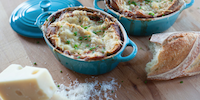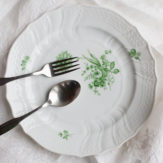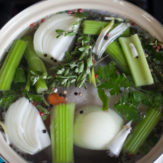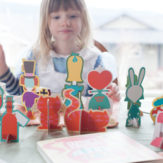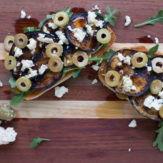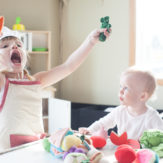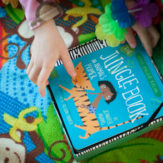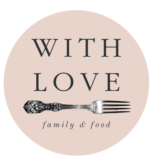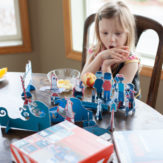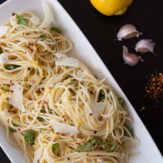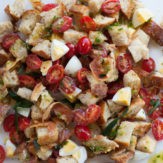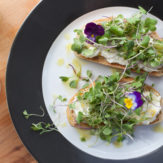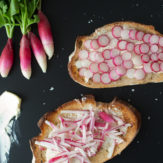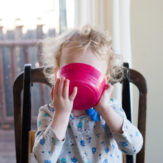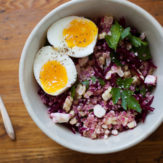|
Category Archives: Cooking with Kids
.jpg) PIN PIN
First off, I want to say THANK YOU all so much for your fantastic feedback on my French Kids Eat Everything post. Clearly we weren’t the only family trying to figure out how to make eating with our kid(s) a pleasurable experience. Everything in this post has been added and incorporated to the original post, so if you prefer you can just read that!
Since posting, I’ve been accumulating some of your questions for a big Q&A post, including some of my own questions that I emailed to my cousin in France!
If you have questions, please leave them in the comments and I’ll do my best to answer them all next week!
A few updates…
Setting the table…
I mentioned briefly that we set the dinner table every night for dinner. I wanted to be more specific about that. We have Gigi help us set the table. She picks out her place mat, plate, fork/knife/spoon, and cup and puts them on the table. Some evenings she’s more excited about helping than others but she usually eagerly participates. We always ask her to use the appropriate utensils while eating. She struggles with successfully using the utensils with every dish and usually uses them and her hands, but she’s learning.
Patience…
In the book French Kids Eat Everything the author, Karen, talks a lot about how important it is for kids to learn to wait patiently. That’s part of the reason we all wait until we are seated and have said what we are grateful for. Last night we were all starving (dinner was a bit late) and I said to her, “Wait, what are you grateful for.”, and she looked right at me and said, “No Mama. I can’t.”, and started eating! Actually I was right there with her! But most of the time it’s a great opportunity to ask a small bit of patience from her… occasionally she even stops us from taking the first bite by saying, “WAIT! I grateful…..” These little “grateful” moments have become some of my favorite Gigi quotes. The other night she said, “I grateful…. maybe…. PENIS!!!” Ha. She’s learning about anatomy.
The point is, I find that she’s been getting more and more patient as a result of these little moments. I find that I can say, “You can have this when we get home.”, or “We can do/have/read/see that in a little bit.” I think it’s a lot about building trust. She knows that I will follow through with it.
Vegetables before dinner…
In my original post, I mentioned that we don’t always do the veggie course first. Usually it’s a part of the meal. I thought I should give some specific examples. If our dinner is veggie heavy (like veggie lasagna) than we don’t normally have another veggie before dinner. But If I’m introducing a new vegetable, or if the vegetable is likely to get ignored in favor of pasta, than I will serve it first. I also am sure not to give her too much pasta. We are trying to follow the rule that she has to at least try/taste everything on her plate before she can have more pasta. We ask that she eats three bites of everything before she can have more of something she’s finished (usually pasta or bread which almost always gets eaten first)! And then it’s only a few bites worth of the pasta. For example, I love making Penne with Butternut Squash, Goat Cheese and Prosciutto for dinner but when I serve it up for her I make sure to only give her a little pasta along with everything else. That way she’s “forced” to eat other things before she can have more pasta. In other words, we try to keep everything in balance. If she has a few bites of everything she can have a few more bites of pasts. Sometimes we don’t giver her any more pasta until her plate is (mostly) clean. I do this when I know it’s a dinner she loves. With the Butternut Squash pasta dish, I know that she has learned to love the squash, the goat cheese, the prosciutto, and she’s working on the basil and red onion. So, I know that there is plenty of food on her plate that she enjoys.
This is what our current eating schedule looks like…
7:30 breakfast
12:00 lunch
3:30 small snack and 1/2 cup milk
6:00 dinner
7:30 bedtime
Snack time…
I was finding at times the Gigi didn’t seem totally hungry at dinner time so we cut back the quantity at snack time, we try to keep to about six bites. She’ll have half a piece of buttered toast, a few bites of yogurt and a couple slices of apple, one cookie. I try to avoid protein as much as possible.
Eating together…
When I did the original post, we were mostly focusing on dinners, I was planning and making breakfast and lunches but we weren’t really eating them together regularly. But, over time we saw that Gigi was acting out a bit at those meals. Dropping food on the floor. Spilling her water on purpose. So we determined that having someone sit with her and eat with her would be a good thing, for all of us! Kyle and I both usually skip breakfast, or I would find that I wanted carbohydrates around 10am because I didn’t eat something healthier in the morning (I’m blaming pregnancy for part of this). Now we usually sit down together and have a bit bowl of fruit and yogurt or eggs and whole grain toast. The social eating aspect of the French approach really does make a big difference. Now she eats at all meals and is getting better at telling us when she’s all done (as opposed to “showing” us by smearing food on the table).
For those of you who mentioned getting your babies with few teeth to start eating solid foods, I would recommend reading Baby Led Weaning. I haven’t read it myself but it’s been recommended by a few friends and my sister has had great success with it. Her nine month old eats everything (seriously, everything). The concept is essentially no purées. I’m ordering a copy to read before our daughter is born!
A few thoughts on dessert…
We don’t have dessert every night. But if Gigi has had a particularly great meal and tried everything on her plate, I’ll often cut up an apple for us all to share, or we will each get five or six chocolate chips, or a little ice cream. I don’t think of it as a reward and I don’t tell her that it’s because she ate everything. It’s simply because I think she earned it. She doesn’t get to the end of each meal and ask for a treat but when she does it’s a good opportunity to say: “Yes. We all tried everything and I think it would be fun to have _____.” or “No. We aren’t going to have dessert tonight because we didn’t try everything on our plate.” She seems to understand both answers. One thing to keep in mind too is that she has no idea or expectation about what dessert entails. The other night Gigi asked me, “We have a treat?” and I told her, “I got nothin’!”, and she got so excited and squealed, “OH BOY!” It was so sweet, I got up and found a little something. But it taught me that, she doesn’t know of care what’s for dessert… it’s just the idea of having earned something.
Being patient…
This has been and continues to be a process with ups and downs. We try to enjoy every little success and not get caught up with “failures”. I feel really proud that G has learned to eat and love squashes, cucumber, potatoes, zucchini, kale, carrots, radishes (and those are just a few the vegetables) and willingly tries everything from broccoli to eggplant. Sometimes they go in, get chewed a bit and come back out but we don’t say anything or make a big deal out of it… I think it’s a success that she’s trying it and I’m confident that things will make it to her stomach eventually. She seems to be outgrowing her “sensitivity” to texture. I find it really helpful to talk about new foods, at the store, while being prepared, while being served. For example: At the store: “These radishes are pretty! What color are they?” While preparing: “This radish is white on the inside! Can you help me put it on our salad?” While eating: “What does it taste like? Is it crunchy like an apple? Maybe it’s a little spicy?” The more she’s in an exploratory state of mind the more she seems to eat! I still cannot get her to enjoy green peas on their own (it’s fine if they’re mixed into a dish)… tasting these usually means licking one… but I am confident we’ll get there eventually. But I don’t worry too much about it. I also feel comfortable that if she decides she really does not like green peas, then that’s her choice. She’s eating enough variety of vegetables that I don’t worry about it. She does have her own individual tastes, as we all do. We will all measure our little successes differently since our kids are all different. For me every time she tries, eats, enjoys, says “that’s tasty!” to a new food, I feel proud and I count that as a success.
I hope this is helpful! Please post your questions and I’ll answer them next week along with some answers from France!
.jpg) PIN PIN
After reading French Kids Eat Everything and following that approach to menu planing for the past six months, I reworked the way I was menu planning to meet the new way I was feeding my family. This meant not only planning dinners but also planning out breakfasts, lunches and snacks. At first I found this really overwhelming and couldn’t figure out a way to keep track of it all. I struggled (and still do sometimes) with trying to cover the entire days worth of food, seven days a week for my family but this method has streamlined the process and made it enjoyable and affordable!
It can seems a little overwhelming at first so I’ve broken it up into a few separate parts…
Three Steps to Menu Planning
01. Cookbooks and Organization
.jpg) PIN PIN Menu Planning // Step One Menu Planning // Step One
One issue I continuously had when menu planning was that I can’t always find the time to browse through my cookbooks for inspiration and recipe ideas. Before we had Gigi, Kyle and I would spend our Sunday morning in bed, with our cookbooks and our coffee, making a menu for the week… now I need this process to be much more efficient. I used to plan for a week at a time but I personally find that doing a month at a time makes it so much easier, takes less time, and helps me keep our whole month’s budget in mind.
I went through every cookbook we owned, one at a time, using little Post-It’s to flag the recipes that looked good, that I regularly made, or that I had always wanted to make. If I went through a cookbook and only found one of two recipes that I liked/used I just put that cookbook in the pile for a the used bookstore… there are so many amazing cookbooks and recipes and streamlining the number of cookbooks I had really helped this process.
THEN I went through the cookbooks and typed all the recipe titles into the following categories: Breakfast. Lunch. Snack. Dinner (split into entrees/sides and main courses). Dessert. Drinks. Basics and Techniques. I also created hyperlinks in my document to my favorite food blogs. You could create as many or as few categories as you need for your family. Since I’m a stay at home mama who loves to cook (and eat) I needed all of them! Each section is divided up with headings for each cookbook. For example under BREAKFAST I have six different cookbooks that I took recipes from.
The BREAKFAST section looks like this:
BREAKFAST
My Father’s Daughters.Gwyneth Paltrow
sweet rice bowl GP.236
morning pancakes GP. 221
spiced apple crumb muffins GP.224
favorite granola GP.227
bruce’s world-famous pancakes GP.239
Sprouted Kitchen.Sarah Forte
breakfast tostadas SK.28
scrambled eggs and leeks SK.32
vegetable eggs benedict SK.31
softly scrambled eggs with creamy leeks SK.32
carrot-date muffins SK.34
creamy coconut barley with pomegranate molasses SK.39
tofu quiche in rosemary-almond meal crust SK.44
granola protein bars SK.154
green smoothie SK.162
…you get the idea. I gave each cookbook and a code before the page number so when I’m menu planning I don’t have to write our “Sprouted Kitchen” every time, just SK and the page number!
This process took a couple of weeks to complete but it was really enjoyable, I made tea and flipped through my beloved cookbooks with a stack of Post-It’s at hand. Admittedly putting them into a document on the computer felt a little tedious but I just I tackled one cookbook every other day or so and now that it’s done I’ve found that the menu creating process is really fast and filled with variety.
Here is a list of my current cookbooks:
My Father’s Daughter // Gwyneth Paltrow
It’s All Good // Gwyneth Paltrow
The Sprouted Kitchen // Sarah Forte
Start Fresh // Tyler Florence
Super Natural Every Day // Hedid Swanson
Joy the Baker // Joy Wilson
Very Fond of Food // Sophie Dahl
Spain: A Culinary Road Trip // Mario Batali
Tyler’s Ultimate // Tyler Florence
Jamie’s Kitchen // Jamie Oliver
Everyday Italian // Giada de Laurentiis
I also have some bigger cookbooks like America’s Test/Cook’s Illustrated Kitchen Family Cookbook, Interational Recipes, and New Best Recipes. I also have Mastering the Art of French Cooking and The Joy of Cooking. I didn’t go through these since they are so packed with recipes. I tend to reference them as needed or when I’m looking for something specific.
Some cookbooks on my wishlist:
Miss Dahl’s Voluptuous Delights: Recipes for Every Season, Mood, and Appetite
Tender: A Cook and His Vegetable Patch
The Art of Simple Food: Notes, Lessons, and Recipes from a Delicious Revolution
Plenty: Vibrant Recipes from London’s Ottolenghi
The Smitten Kitchen Cookbook
What Katie Ate: Recipes and Other Bits and Pieces
It’s All Good: Delicious, Easy Recipes That Will Make You Look Good and Feel Great
Miette: Recipes from San Francisco’s Most Charming Pastry Shop
The Sugar Cube: 50 Deliciously Twisted Treats from the Sweetest Little Food Cart on the Planet
Tartine
Home Made
Bouchon Bakery
…and so many more! What are your favorite cookbooks?
My favorite food blogs:
Gorge in the Gorge
(this is my food blog so i use a lot of recipes from here!)
GOOP
Joy the Baker
Orangette
101 Cookbooks
Call Me Cupcake
Cannelle et Vanille
Dinner or Dessert
La Domestique
Love and Olive Oil
Naturally Ella
Not Without Salt
Reclaiming Provincial
Smitten Kitchen
Sprouted Kitchen
Sunday Suppers
Tartelette
The Forest Feast
What Katie Ate
Step 02 / Menu Planning and Grocery Shopping Lists
 PIN PIN
The second step is using those recipes to create a monthly menu that is full of variety and sticks to your budget. I think shopping within a reasonable budget is the hardest part of meal planning. It definitely the most “troublesome” part of our family budget. It’s a challenge to stay under $450 (our monthly goal) but this method makes it easier. I also have some tips for budget friendly grocery shopping that I’ll share in Step Three.
I’ve broken my monthly planning down into week by week menus. I plan out breakfasts, lunches, snacks and dinners. I don’t plan out desserts since we don’t have it every night. Lately, when I’m at the store I just buy whatever fruit looks good, then we’ll share an apple or a banana and a few chocolate chips. If we have ice cream, or if Gigi and I have baked a little cake then we’ll have that. I plan out each week using a little budget code (under $5 / $=5-10 / $$=10-15 / $$$=15-20 / $$$$ = 20+). I write in my estimate next to the meal and I try to keep most of my meals in the “under $5” category. A – indicates that there is no cost because it’s leftovers. It depends on your budget and the size of your family, but I find that this little system helps me see when I’m planning too many pricey meals. These menu plans actually end up covering a little over a month since we usually do a day here and there using up what we have in the fridge, or we get invited out to dinner and have extra food on hand for a meal or two.
 PIN PIN So, I fill out the menu using my recipe document and selecting this off of my favorite foodie blogs. I make my menu plan on the computer which makes it easy because I can just copy and past the recipe from my cookbook document or hyperlink the online recipe directly into this format. I try to keep notes about what new foods I introduced to Gigi to keep in mind the French Kids Eat Everything method we’ve been following. I also make sure to note when I can “make one, freeze one” and double that recipe and put one in the chest freezer in the garage. Where you see “RECIPE” written out is a meal that I’ve dedicated to creating or working on a new recipe. You could also leave space for spontaneous meal planning. So, I fill out the menu using my recipe document and selecting this off of my favorite foodie blogs. I make my menu plan on the computer which makes it easy because I can just copy and past the recipe from my cookbook document or hyperlink the online recipe directly into this format. I try to keep notes about what new foods I introduced to Gigi to keep in mind the French Kids Eat Everything method we’ve been following. I also make sure to note when I can “make one, freeze one” and double that recipe and put one in the chest freezer in the garage. Where you see “RECIPE” written out is a meal that I’ve dedicated to creating or working on a new recipe. You could also leave space for spontaneous meal planning.
 PIN PIN  PIN PIN Once I’ve created the entire months menu I get down the corresponding cookbooks and pull up the food blogs. Then I go week by week to create a grocery shopping list for each week. I put everything I can (non-perishables) onto the week one grocery list. By buying everything I can at the start of the month I accomplish a few things. First, it allows me to spend the bulk ofmy grocery budget up front and then I know how much I can spend the remaining three weeks. Second, it means I have one big grocery shopping trip each month. The rest of the month I have short trips to pick up fresh produce, poultry and dairy. Third, it gives me a chance to look for things on sale and buy them early on and stick them in the freezer for later in the month. Finally, this also means that I only have to look through the pantry/freezer/spice cabinet once each month instead of weekly to see if we already have this or that! Once I’ve created the entire months menu I get down the corresponding cookbooks and pull up the food blogs. Then I go week by week to create a grocery shopping list for each week. I put everything I can (non-perishables) onto the week one grocery list. By buying everything I can at the start of the month I accomplish a few things. First, it allows me to spend the bulk ofmy grocery budget up front and then I know how much I can spend the remaining three weeks. Second, it means I have one big grocery shopping trip each month. The rest of the month I have short trips to pick up fresh produce, poultry and dairy. Third, it gives me a chance to look for things on sale and buy them early on and stick them in the freezer for later in the month. Finally, this also means that I only have to look through the pantry/freezer/spice cabinet once each month instead of weekly to see if we already have this or that!
Important Note: I l keep the menus on the fridge so I can always see what’s coming up for the week. This keeps me excited about what on the menu, aware of what I’ve already spent money on and far less likely to order take out.
I love grocery shopping with my daughter but sometimes it feels like it takes up the entire day! I split my grocery list up into “parts of the store” which makes it easier to efficiently shop, it also makes it easier for Kyle when I send him to the store. I spend so much less time criss-crossing the store because I forgot something on the other side! This might vary a little depending on the layout of your store. I also added a separate section of stopping by the co-op or farmer’s market, and for things we need from Safeway or Trader Joe’s (which aren’t our usual grocery stores).
Here is a look at my blank document for grocery shopping… (you can print this at the end of the post)
 PIN PIN
And here’s what a few of my lists look like…
 PIN PIN
You can see my grocery list for Week 1 is bigger than the others! Last month I spent $95 week one and I’ve spent around $50 each additional week. Along with little trips to the store here and there we are sticking pretty close to our budget.
I know this all looks like a lot of work (and it is) but it’s totally worth it! I find a day at the end of the month and spend long morning making up the menu and grocery lists for the month. Then the work is done for the whole month! I don’t have to stress about it every Sunday, I just grab the next week’s menu and list. A major benefit to planning this way is that, once you have several months of menus made up you can always go back and print an old month when you’re in a time crunch.
PRTINABLE MENU TEMPLATE.
Monthly Menu Template
PRINTABLE GROCERY TEMPLATE.
Grocery List Template
Step 03 / Top Tips for Shopping on a Budget and Shopping with Kids
 PIN PIN Keeping groceries within our budget can be a big challenge for us. We love to cook and eat and our grocery store spending can easily get out of hand. When we are really tightening our belts I can get our budget down to $200/300 per month but that isn’t very sustainable for us. We set our budget at $450 which gives us enough to eat wholesome foods, create a couple recipes and maybe splurge on ice cream. Keeping groceries within our budget can be a big challenge for us. We love to cook and eat and our grocery store spending can easily get out of hand. When we are really tightening our belts I can get our budget down to $200/300 per month but that isn’t very sustainable for us. We set our budget at $450 which gives us enough to eat wholesome foods, create a couple recipes and maybe splurge on ice cream.
Top Tips for Grocery Shopping on a Budget
Buy everything you can at the start of each month.
When I make my monthly menus I also make my whole months worth (four in total) of grocery lists. I put everything I can on the list for week one. Anything non-perishable goes on the first shopping list for the month. That way I spend the bulk of my grocery budget up front and I can keep that in mind the rest of the month. This really helps be know approximately how much I have left to spend each week. You can read about this in depth here.
Only buy what is totally necessary from the organic section.
I used to buy all organic but our spending dropped significantly when I started buying conventional again and only buying what was totally necessary from the organic section. This summer we’ll have a big garden planted and the local farmers’ market will be up and running so we will be able to eat more organic vegetables then! I just can’t afford to buy them from the store at this time in our life.
The most important things to buy organic are thin skinned fruits (apples, peaches, nectarines, grapes), thin skinned or exposed vegetables (bell peppers, celery, spinach, kale, collard greens, lettuce), potatoes, tomatoes, berries (especially strawberries and blueberries), red meat, high fat dairy (milk, butter). Organic dairy isn’t in our budget so I buy the Sunshine brand which is rbST free.
Wash and store fruits and vegetables properly.
Always make sure to wash and store your fruits and veggie immediately. I soak leafy greens and fresh herbs in a cold water bath, wrap them in paper towels and store them in ziploc bags. Quickly rinse fruits and store them in the proper drawer or in a fruit bowl on the counter. When I do this I find that the veggies last longer because they’re stored properly and I’m more apt to use them because they’re already washed! Likewise when the fruits are clean and on the counter in a nice bowl I use them quickly because they look appealing and are at my fingertips.
Buy in bulk whenever possible.
I buy everything I can in bulk. Mostly I buy dried fruit, flour, olive oil, dried beans, corn meal, rice, spices and herbs, oats, nuts, vanilla and honey. Even buying the bag of organic potatoes vs. individual potatoes can save quite a bit! The cost per volume is almost always better when you are buying in bulk.
Be thoughtful about what you stock up on.
I used to stock up on everything… I’d just buy three of things when they were on sale. But I found that cans of this or that sat around forever so I was actually wasting money up front (rather than saving it). The main things I stock up on now are broths (I love the low sodium, organic Trader Joe’s brand of chicken and veggie broths. I buy a case of each when we go!) I also stock up on cheeses like goat cheese, Parmesan, mozzarella and cheddar. As long as the cheese is sealed in it’s original packaging it should last for quite some time. Trader Joe’s is also a great place to buy cheese! Now when we go to Costco we only buy household products and skip the majority of the food. It’s so easy to buy things you don’t need because they’re such a good deal!
Buy and freeze.
The main things I buy and freeze are whole grain bread and chicken. In fact I only buy bread when it’s on sale. Often whole grain bread can be 50% off when it’s close to the expiration date. I’ll buy two and freeze them both. I try to only buy chicken when it’s on sale, and usually in larger quantities like the “fryer packs”, then I divide it up into dinner size ziploc bags, write the date on them and pop them in the freezer. Because the menu planning is done for the month all at once I have plenty of time to see what I already have and pull it out to defrost in the fridge.
Make one, freeze one.
One big thing I do is to double recipes and freeze one. I especially try to do this with meals that are inexpensive like my Tuna Noodle Casserole, Enchiladas, and lasagnas. But I also do it with Chocolate Chip Cookies, homemade pizzas… anything that will freeze well. This gives us convenient, inexpensive meals and it doesn’t add much time to make two instead of one.
Skip the boneless, skinless variety of chicken breasts.
You can save a ton by buying bone in, skin on breasts instead of boneless skinless breasts and they cook so much better! A little bit of olive oil, salt and pepper roasted on a cookie sheet at 375 degrees F for about 45 minutes and you’ll have the most tender, flavorful chicken breasts. Once they’ve cooled a tiny bit just remove the skin and cut the meat from the bone. I shred these for enchiladas and salads, dice them for chicken salad sandwiches, etc.
Use what you have.
This may seem obvious but it’s easy to get lazy when making menus and not get up to look to see if you already have a can of tomatoes in the pantry or a bottle of red wine vinegar in the fridge. A few dollars here and there really adds up. Because the menu planning and grocery list making is all done at once (with my method) that means you only have to search through the back of the pantry/spice cabinet/freezer once each month!
Also we always have a couple of “pantry meals” towards the end of the month when we try to use the other half of the jar of pasta sauce, the half used box of pasta, the milk that’s about to expire, the vegetables on the edge of perishing. They aren’t always the most creative, fun, or prettiest meals but it feels good to know that we used everything we could and didn’t waste anything!
Keep the season in mind.
It’s always less expensive (not too mention better for the environment) to buy what’s in season and grown locally. During the fall and winter our grocery spending always goes up since it’s harder to buy seasonal/local during the colder months. I try to pinch pennies but using hearty herbs like thyme, sage and rosemary in the fall and using dried herbs in the winter. I avoid buying things like fresh tomatoes, tropical fruits, etc. in the colder months. In just a few weeks we will be planting all of our vegetables in the ground and then we’ll be counting the days until our garden is in full bloom!
Edit your recipes.
I always try to edit recipes by omitting things that I don’t feel are totally necessary. I cut out things that are expensive or specialty items that are hard to find or will cost too much. I do this each month when I’m making the grocery list… when I come across an item I know is pricey I simply make the choice whether or not we can afford it within our budget. A lot of times I cut out the fresh herbs like basil or mint during the fall and winter, and if it’s appropriate, I substitute with less expensive options like flat leaf parsley. I also substitute expensive items like Gruyere cheese for a little blend of mozzarella and Parmesan. It does effect the recipes to some extent but I can’t afford to spend $2.50 on a handful of fresh herbs that are a garnish.
Shop at more than one grocery store.
I have to admit, I hate this step, but it’s a necessary one. For some reason I hate going to Safeway but they often have items that are less expensive than our favorite grocery store. I get everything I can from our main store but set aside a few things on our list from Safeway or another store… I buy all of our wine at the drug store where it’s usually a couple dollars less! To be honest I usually make Kyle do the Safeway run because he can do it on his way home from work and I don’t have to drag Gigi to another store.
Skip the processed foods.
Processed foods are expensive! The only things we buy from the middle of the grocery store (where processed foods are kept) are bread, canned/jarred tomato products, frozen berries, wine/beer, vinegars, mustard, coffee and tea. I never buy crackers or cookies or things like that. You can save a lot of money by making your own salad dressings, dry rubs or marinades. My favorite salad dressing is the Caesar Salad Dressing in this recipe.
Top Tips for Fun and Efficient Grocery Shopping (with kids)
Make it as fun as possible.
I don’t always look forward to going grocery shopping. In fact, sometimes I dread it. But I try to keep in mind that grocery shopping is something I will be doing every week for the rest of my life so I may as well make the best of it. Also, if I’m not having fun, neither will my kids. When I am in a good mood about it, organized, and upbeat, it usually ends up being a pretty fun errand. It’s a chance to teach Gigi about food, interact with other people, and do something that benefits my family.
Plan menus by the month.
By menu planning by the month (as opposed to week by week) I save a ton of time. The time is spent in one big chunk up front at the start of each month and the first grocery shopping trip is the most time intensive, but the rest of the month the trips are short and sweet. I just pick up fresh fruit and produce, meat, eggs and dairy. After the first big trip we usually go out for a little lunch or I plan something simple like peanut butter and jelly sandwiches. We always come home hungry and since I’m spending the time putting away our groceries and washing our veggies it works best if I have something simple planned.
Don’t give kids food at the store.
With the exception of a slice of apple which Gigi’s favorite produce guy slices for her, I don’t let her have any food at the store. I know a lot of parents who give their kids treats upon entering the store, or at the end of shopping as a bribe and I don’t doubt that it works well but we stick to our French Kids Eat Everything ways and I don’t let her snack and I don’t use food as a bribe or reward (sometimes I wish I did). Because I’ve been really consistant about this Gigi doesn’t usually ask for food while we are shopping. Occasionally she’ll spot a squeeze packet of baby food and will say, “I need dat! Peeeeeease Mama? I ask nicely.” But I stick to my rule and tell her, “No but as soon as we get home we’re going to have _________ (something fun) for lunch!” She usually handles this just fine. If she gets frustrated, I talk to her about how great lunch is going to be, how I got strawberry jam for her sandwiches, etc. Just talking about food she’s going to get to have is enough of a distraction.
Give kids a food related activity.
A great activity for kids at the store is to give them their own list. Gigi was always grabbing mine and didn’t want to give it up when I actually needed it. So I make her her own list with little drawings of items are on our list for the week/month. I draw little pictures and write the names of the foods next to them… I try to focus on new foods that we’re introducing. Then I give her a pen and she “helps”. The list usually gets tossed aside or torn into pieces by the end of our big trip to the store but it buys quite a bit of time and it gives us a chance to talk about new foods we are introducing that month! (You can download her March list below but I’m not exactly an accomplished artist)
 PIN PIN
 PIN PIN
When we were on our trip to Europe this summer, I read French Kids Eat Everything by Karen Le Billon. It was eye opening for me because, although we encouraged Gigi to eat and try “our food” we were missing the main point! “Our food” is also her food! I felt that we were asking something extraordinary of her to eat exactly what we were eating and we’d often follow up an offer of “our food” with something more “kid friendly”. She’s always been low in weight so we were concerned that she wasn’t eating enough and would always whip up something (after dinner) in order to ensure she got enough.
Before reading this book Gigi’s typical day was filled with scrambled eggs, quite a few snacks, milk, a tiny lunch, some of our dinner food (most of which ended up on the floor) or a customized toddler dinner (most of which ended up on the floor). We didn’t often eat together. Most of the time we gave Gigi dinner earlier in the evening and then we ate after she was in bed.
After reading French Kids Eat Everything I was a total convert to the idea that kids eat what adults eat. Period. I read, re-read, took notes and came home from our trip with a plan to change our ways. We’ve now been eating the “French” way for five months so I feel confident in sharing our experience with you. The rules are simple and following them has made a huge difference in the way we all eat.
The French Kids Eat Everything Rules
…and my thoughts on applying them at home…
1. Parents are in charge of children’s food education.
I simply talk to Gigi a lot more about food, she cooks with me more. We bought her these veggies, fruits and fish sets from Ikea and she cooks in her little kitchen. We ask her to make us dishes using specific toy food. She’s only two but as she gets older these conversations and games will change. We’ve started to talk about color, texture, and flavor as well.
2. Avoid emotional eating. Food is not a toy, a distraction, a bribe, a pacifier, a reward, or a substitute for discipline.
This rule brought on a wave of mom-guilt. Before reading this book I constantly used food as a toy, distraction and pacifier. Fussing in the car? Here’s some crackers in a snack catcher. Bored on a walk? Here’s a squeezy pack of baby food. When I realized that I was teaching Gigi that “food is the answer” to boredom, crankiness, etc. I felt really guilty. What kind of food habits was I setting her up with? We ditched the squeezy packs which are now in the emergency bin in the car for emergency only or reserved for long trips, and the snack catcher is now a bath toy.
3. Parents schedule meals and menus. Kids eat what adults eat: no substitutes and no short-order cooking.
This took surprisingly little adjustment on Gigi’s part! Since she wasn’t snacking she was really hungry when it came to be dinner time. The first day on the program she refused dinner and went to bed hungry. It sounds harsh but it was actually fairly smooth. She didn’t complain, she just didn’t want what was offered so we ate, read her a book and put her in bed. (She ate an enormous breakfast the following morning). Now things run smoothly. She’s used to being served what we are eating. She gets to make some choices at breakfast between a couple options we offer her… daily requests for waffles and cereal are not honored.
4. Food is social. Eat family meals together at the table, with no distractions.
We set the table every night for dinner, sit down together, say what we are grateful for, and then we eat. We have Gigi help us set the table. She picks out her place mat, plate, fork/knife/spoon, and cup and puts them on the table. Some evenings she’s more excited about helping than others but she usually eagerly participates. We always ask her to use the appropriate utensils while eating. She struggles with successfully using the utensils with every dish and usually uses them and her hands, but she’s learning. We never answer our phones (in fact they’re not allowed near the table), we try to include Gigi in our conversations and engage her by asking her questions. We ask her to eat like an adult! Family dinners are truly the best part of my day.
5. Eat a variety of food. Eat vegetables of all colors of the rainbow, don’t eat the same dish more than once per week.
We try to introduce lots of different foods to Gigi. We often eat the same dish more than once per week because we have leftovers. Cooking something new every night isn’t financially feasible for us. I am working on adding more veggies to the roundup.
6. You don’t have to like it but you have to taste it / eat it.
Using the word “taste” instead of “try” seems to work really well with Gigi. I feel like when I encourage her to “taste” something, I’m asking her to be adventurous and curious. The word “try” feels like I’m asking her to judge it, to decide if she likes it or not. We always put a bit of everything on her plate. If she refuses a food or tastes it and says, “I don’t want that!” We remind her that the polite thing to say is “no thank you” then we say, “That’s okay. We’ll taste it again another time”. Then we take it away or encourage her to leave it on her plate and assure her that she doesn’t have to eat it.
7. Limit snacks to one per day and not within one hour of meals. In between meals, it’s okay to feel hungry. At meals, eat until you’re satisfied, rather than full.
This was challenging when i was in the first trimester of pregnancy and we often shared a bagel and cream cheese on the couch (off schedule) but we’re back on track now. I actually have grown to love snack time. Since the idea is to give something high carbohydrate to give a boost of energy and tide kids over until dinner, I feel like I don’t have to be totally “responsible” at snack time. We often have things like cinnamon sugar toast, cookies and milk, a little trail-mix spiked with M&M’s, along with other snacks like apples and cheese, ants on a log, etc. It’s fun to get to throw something together for her or surprise her with a mid-day cookie. A typical French snack for kids is a bit of baguette with butter and melted chocolate! I was finding at times the Gigi didn’t seem totally hungry at dinner time so we cut back the quantity at snack time, we try to keep to about six bites. She’ll have half a piece of buttered toast, a few bites of yogurt and a couple slices of apple. I try to avoid protein at snack time.
8. Take your time, both for cooking and eating. Slow food is happy food.
This rule is easy for us. If you’ve been following this blog, you know that I love to cook. I rarely ever buy processed/pre-made food, and we rarely eat out. This means that all of our meals are made from scratch at home. Gigi is getting to the age where she loves to cook with me. She helps, asks questions, sometimes very much gets in the way… and I love it all.
9. Eat mostly real, homemade food, and save treats for special occasions. Avoid processed foods.
As I mentioned above, I make everything at home. And (again with the exception of the first trimester of pregnancy) I rarely buy any processed foods.
10. Eating is joyful, not stressful. Relax and enjoy the process of planning, preparing and feeding yourself and your family.
This rule is important to remember. Sometimes the planning and grocery shopping aspect can be a bit stressful and feels like it takes an entire day but, I love taking Gigi to the grocery store. I love interacting with the people there. I love planning our meals. Feeding my family is such a huge part of our days, weeks, months… why not embrace and enjoy it?
A few other things…
I don’t try to “hide” foods from Gigi. I don’t mix spinach in her brownies or add purées to things without telling her. I always tell her exactly what’s in her food. I don’t personally understand the point or idea of getting her to eat more vegetables if she isn’t going to eat them or learn to love them in their natural form. I don’t think there’s anything wrong with adding veggies to her food but I always tell her. On the same note we talk about what’s for dinner every night. We’ll show her that there’s mushrooms, spinach, ricotta, onion, etc. in her lasagna. I trust that she will learn to like them and I want her to recognize what she’s eating/tasting/liking. On the same note, we also let her eat anything and everything we eat. If we’re having chocolate we give her some. Sweets and candy are part of the food world too. If we eat it in moderation, I believe she will too. But I don’t think it’s fair to tell her she can’t have ice cream when we have it. If she has had too many sweets we’ll put her to bed and then have ice cream but we always share with her if she’s participating in a family event or meal.
In the book French Kids Eat Everything the author, Karen, talks a lot about how important it is for kids to learn to wait patiently. That’s part of the reason we all wait until we are seated and have said what we are grateful for. Last night we were all starving (dinner was a bit late) and I said to her, “Wait, what are you grateful for.”, and she looked right at me and said, “No Mama. I can’t.”, and started eating! Actually I was right there with her! But most of the time it’s a great opportunity to ask a small bit of patience from her… occasionally she even stops us from taking the first bite by saying, “WAIT! I grateful…..” These little “grateful” moments have become some of my favorite Gigi quotes. The other night she said, “I grateful…. maybe…. PENIS!!!” Ha. She’s learning about anatomy. The point is, I find that she’s been getting more and more patient as a result of these little moments. I find that I can say, “You can have this when we get home.”, or “We can do/have/read/see that in a little bit.” I think it’s a lot about building trust. She knows that I will follow through with it
We don’t battle over food. She rarely asks for snacks now that she’s used to the schedule. If she does I just say, “We’ll have a snack at snack time!” I avoid using the word “no” but I make it clear that it’s not snack time/we can’t have cookies for breakfast, etc. If she doesn’t want to eat something, that’s fine. There’s no use in battling. I would rather that we talk about it than have her hiding her peas in her napkin, and I will never tell her she can’t leave the table until she’s finished her cauliflower. That’s not fun for anyone! I won’t force her to eat a certain food. I want her to enjoy the process of learning about and exploring different foods. I feel that the power is in what I put on the table, rather than what I make her eat. After years of nannying I’ve learned that finding creative ways of avoiding a power struggle with a toddler is a major skill. At the table it’s particularly important.
Incorporating variety is challenging. We eat a lot of vegetables and fruits, but it’s not always easy to introduce new foods. Sometimes it’s downright defeating! But it does come around and work eventually. For example, some foods that Gigi refused and now loves: potatoes, onions, roasted garlic… it takes time but is really rewarding when she finally embraces something new. It seems that once she’s accepted something, potatoes for example, she’ll eat in all forms when we tell her what it is.
We try to eat all our meals together. At first, I was planning and making breakfast and lunches but we weren’t really eating them together regularly. But, over time we saw that Gigi was acting out a bit at those meals. Dropping food on the floor. Spilling her water on purpose. So we determined that having someone sit with her and eat with her would be a good thing, for all of us! Kyle and I both usually skip breakfast, or I would find that I wanted carbohydrates around 10am because I didn’t eat something healthier in the morning (I’m blaming pregnancy for part of this). Now we usually sit down together and have a big bowl of fruit and yogurt or eggs and whole grain toast. The social eating aspect of the French approach really does make a big difference. Now she eats at all meals and is getting better at telling us when she’s all done (as opposed to “showing” us by smearing food on the table).
There is enormous freedom in a schedule and routine. Because we are on a set schedule and the habits have now become engrained, I feel a huge sense of freedom with our meals. We can have a picnic on the floor, be lazy and give her a big plate of pasta, eat popcorn on the couch in the middle of the day… occasionally. Then we can get right back to our better eating habits the next day. In the same way that we put so much energy and effort into creating good sleep habits, then we could keep her up until 10pm on the 4th of July without risking total overhaul of sleep patterns, we can ignore the food rules from time to time because we know that the foundation is there to return to. By no means are we perfect “method” followers… some days are an absolute mess and Gigi has snacks all day and cereal for dinner! Some days are just like that, but we always have good intentions and get back on track as soon as we can.
I’m so glad we’ve started early with Gigi. I wish we’d started even earlier but I’m happy that we’re eating this way now. I do think we got off on the wrong foot with baby food. We will be following the French method this next time around: introducing a different menu of foods early on, skipping rice cereal all together. Karen has a great write up about feeding babies the French way here. For those of you who mentioned getting your babies with few teeth to start eating solid foods, I would recommend reading Baby Led Weaning. I haven’t read it myself but it’s been recommended by a few friends and my sister has had great success with it. Her nine month old eats everything (seriously, everything). The concept is essentially no purées. I’m ordering a copy to read before our daughter is born!
The Main Differences in Our Eating Habits
The Schedule:
The eating schedule proposed and followed in French Kids Eat Everything is:
Breakfast in the morning
Lunch around 12:30pm
Snack around 4:30pm
Dinner between 7:00pm and 8:00pm
It took a while for us to get on this schedule as we transitioned Gigi from one to two naps (she used to nap through lunchtime). Now our daily schedule looks like this:
7:30 breakfast
12:00 lunch
3:30 small snack and 1/2 cup milk
6:00 dinner (bedtime is at 7:30pm)
Our schedule is a tiny bit earlier than the French one provided in the book. It works perfectly for us.
Lunch:
Gigi still eats a rather small lunch. I do feel that I could do better making her bigger/better lunches with more variety. This has been a hard habit for both of us to change. In France, lunch is the biggest meal of the day. Here, dinner is. So while I’m working on adding variety, I’m not totally concerned about the size of her mid-day meals. I’m not trying to make lunch the biggest meal because that’s not realistic given my husband’s work schedule and our calorie needs at the end of the day. Also since children aren’t fed big wonderful lunches at school I have a feeling our kids will come home from school needing a big dinner!
Dinner Menus:
One big difference between the French eating habits and ours is the dinner menu plans. The typical French dinner includes a vegetable entrée (starter), plat principal (main dish), salade/fromage (cheese), and dessert. If our dinner is veggie heavy (like veggie lasagna) than we don’t normally have another veggie before dinner. But If I’m introducing a new vegetable, or if the vegetable is likely to get ignored in favor of pasta, than I will serve it first. I also am sure not to give her too much pasta. We are trying to follow the rule that she has to at least try/taste everything on her plate before she can have more pasta. We ask that she eats three bites of everything before she can have more of something she’s finished (usually pasta or bread which almost always gets eaten first)! And then it’s only a few bites worth of the pasta. For example, I love making Penne with Butternut Squash, Goat Cheese and Prosciutto for dinner but when I serve it up for her I make sure to only give her a little pasta along with everything else. That way she’s “forced” to eat other things before she can have more pasta. In other words, we try to keep everything in balance. If she has a few bites of everything she can have a few more bites of pasts. Sometimes we don’t giver her any more pasta until her plate is (mostly) clean. I do this when I know it’s a dinner she loves. With the Butternut Squash pasta dish, I know that she has learned to love the squash, the goat cheese, the prosciutto, and she’s working on the basil and red onion. So, I know that there is plenty of food on her plate that she enjoys.
Dessert:
We don’t have dessert every night. But if Gigi has had a particularly great meal and tried everything on her plate, I’ll often cut up an apple for us all to share, or we will each get five or six chocolate chips. I don’t think of it as a reward and I don’t tell her that it’s because she ate everything. It’s simply because I think she earned it. She doesn’t get to the end of each meal and ask for a treat but when she does it’s a good opportunity to say: “Yes. We all tried everything and I think it would be fun to have _____.” or “No. We aren’t going to have dessert tonight because we didn’t try everything on our plate.” She seems to understand both answers. One thing to keep in mind too is that she has no idea or expectation about what dessert entails. The other night Gigi asked me, “We have a treat?” and I told her, “I got nothin’!”, and she got so excited and squealed, “OH BOY!” It was so sweet, I got up and found a little something. But it taught me that, she doesn’t know of care what’s for dessert… it’s just the idea of having earned something.
Social Aspects:
Since, in France, these rules of no snacking, of eating what adults eat, of scheduled eating are part of the social construct, it is easy to follow. Trying to follow them here isn’t always easy. Gigi is often offered candy or crackers at the store/at play-dates/just before dinner. I try to be selective about when I say no. Within an hour of a meal time? No. A graham cracker while we are at the store? Ok. I don’t offer her these items but when they are shared by/with a friend outside of our home, I try to just go with the flow unless it could truly spoil a meal. On another note, after converting to this method, I’m actually shocked by some of the snacking I see. Every day at the grocery store I see parents searching in their bags for snack catchers, breaking open boxes of crackers, milk boxes, string cheeses, etc. Everywhere we go Gigi is offered snack food: from the cookie counter at the grocery store to the local coffee shop, to the park. Snacking is such an accepted part of our culture. It can be challenging to go against the “snacking culture” but I know I am doing the right thing for Gigi’s short and long term eating habits.
Another tricky thing about the social aspect is when we are eating out with friends. It’s difficult to make Gigi stay at the table while other kids are running around before, during, and after dinner, to make her wait patiently for the food to arrive when other kids are drinking juice/snacking on crackers, to serve her bits of what we’re eating instead of ordering mac and cheese or chicken fingers… But, this is a place that we have made the choice to ask a lot of her. We require her to behave politely, eat healthfully, wait patiently, etc. It’s not always easy but I believe it’s very important for our family. To be clear, I’m not judging what other families do with their kids… I know what’s right for our family and I do my very best to stick to that even when it’s hard. On a side note, if we are at a friends house we generally follow that family’s rules. If the kids are allowed to get down and play while the adults finish eating then Gigi is allowed to get down and play as well. I will add that when we’re heading into a sure to be challenging situation we discuss it ahead of time. For example, as we headed to the in-laws for four nights for Christmas this year, we decided as a family to put the rules on hold. We knew everyone would be snacking and it wasn’t fair to ask Gigi not to particpate. When we arrived we told Kyle’s parents, “Ok, we decided you can just spoil her and give her treats and cookies and snacks this time.” They seemed to enjoy the break in rules as much as Gigi did. They are such wonderful listeners we weren’t too worried about things getting out of hand. They know that McDonald’s is on my “absolutely never, no way in hell” list but if my mother-in-law wants to spoil her granddaughter with home baked cookies… I’m willing to set my rules aside. Food is social, and it’s important for me to remember that there are memories and experiences Gigi should get to have with her friends/grandparents/other kids.
This has been and continues to be a process with ups and downs. We try to enjoy every little success and not get caught up with “failures”. I feel really proud that G has learned to eat and love squashes, cucumber, potatoes, zucchini, kale, carrots, radishes (and those are just the vegetables) and willingly tries everything from broccoli to eggplant. Sometimes they go in, get chewed a bit and come back out but we don’t say anything or make a big deal out of it… I think it’s a success that she’s trying it and I’m confident that things will make it to her stomach. She seems to be outgrowing her “sensitivity” to texture. I find it really helpful to talk about new foods, at the store, while being prepared, while being served. For example: At the store: “These radishes are pretty! What color are they?” While preparing: “This radish is white on the inside! Can you help me put it on our salad?” While eating: “What does it taste like? Is it crunchy like an apple? Maybe it’s a little spicy?” The more she’s in an exploratory state of mind the more she seems to eat! I still cannot get her to enjoy green peas on their own (it’s fine if they’re mixed into a dish)… tasting these usually means licking one… but I am confident we’ll get there eventually. But I don’t worry too much about it. I also feel comfortable that if she decides she really does not like green peas, then that’s her choice. She’s eating enough variety of vegetables that I don’t worry about it. She does have her own individual tastes, as we all do. We will all measure our little successes differently since our kids are all different. For me every time she tries, eats, enjoys, says “that’s tasty!” to a new food, I feel proud and I count that as a success. Sometimes I’m completely surprised by her willingness to eat things: kale salad, pine nuts, gorgonzola, salsa, salad with micro-greens, hot sauce! It’s really a fun process to watch.
So, there you have it! Our “American” experience with French Kids Eat Everything. In the coming weeks I’ll share how I plan our weekly/monthly menus. How I budget our menus. I’ll provide a blank printable PDF of our menu format and our grocery shopping template. I’ll be introducing a new features called My Sous Chef which will be all about cooking with Gigi!
Have you read the book? What’s your experience been? I’m curious to hear and would love to incorporate advice and ideas into our day to day eating habits. If you haven’t read it, I highly recommend this wonderful book!
*There is a difference between picky eaters and an oral-motor/sensory defensive eater. The latter is a child who needs intervention from an Occupations Therapist and Speech Language Pathologist.
 PIN PIN
I know what you’re thinking… tuna noodle casserole sounds so old fashioned. But, I promise, this recipe is not your can-of-soup version. This is an amped up, gourmet, version with a creamy béchamel base. It’s the ultimate comfort food in our house and we often make it for a friend or family in need. It’s easy to double and pop in the freezer too. You can also substitute the tuna for roasted chicken breasts when pregnant. (I buy bone in, skin on breasts, roast them at 375˚F for about 40 minutes/until the internal temp is 170˚, allow to cool, discard the skin and bone, dice up the chicken and toss it in).
TUNA NOODLE CASSEROLE
Ingredients.
1 onion, chopped
3-4 stalks celery, sliced
1/2 cup parmesan cheese, grated or shredded
5 cups of pasta
3 cups cheddar cheese, grated
2 cloves garlic, minced
2 cans chunk light tuna, drained (lower in mercury than albacore)
1/4 cup Italian bread crumbs
2 cups low fat milk
1/2 stick butter
3 Tablespoons flour
1 Tablespoon extra virgin olive oil
1 bay leaf
1 teaspoon salt
1/2 teaspoon freshly ground black pepper
1 1/2 teaspoons garlic powder
1 1/2 teaspoons onion powder
1/4-1/2 teaspoon red pepper flakes (depending on how much heat you like)
1/2 teaspoon dried thyme
1/2 teaspoon paprika
1/2 teaspoon dried oregano
1 teaspoon dried parsley
pinch of nutmeg
Directions.
Bring a large pot of salted water to a boil and cook the pasta until just al dente (usually less than the amount of time recommended on the package). Drain the pasta and return it to the large pot.
Meanwhile, heat up the olive oil in a pan over medium heat and saute the onion (with the bay leaf) until the onion is soft and just beginning to brown, then add in the celery and garlic and cook for 1-2 minutes. Discard the bay leaf. Add the onions, celery, garlic and tuna to the pasta and toss it all together gently.
Preheat the oven to 375 degrees.
In a small saucepan melt the butter, then add the flour. Whisk together until the mixture is smooth and creamy. Add in the milk and whisk over medium-low heat until the mixture thickens into a creamy sauce (usually about 5 minutes), remove from heat. Then, add in all of the seasonings and half of the cheddar cheese and stir it together until the cheese is all melted. Pour the cheese sauce over the pasta mixture and mix gently until it’s all incorporated.
Pour the whole mixture into a 9 by 13 inch baking dish. Sprinkle the top with the remaining cheddar cheese, parmesan and a healthy dusting of the bread crumbs before placing it in the oven. Bake for 20 minutes and then broil for 5-10 minutes to get the top golden and crispy.
PRINTABLE RECIPE.
TUNA NOODLE CASSEROLE
|
.jpg)



.jpg)
.jpg)

.png)
